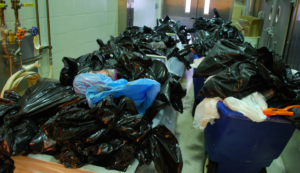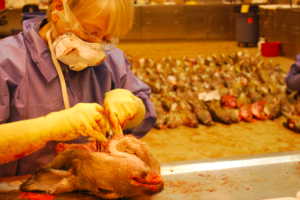
In the Field: Wildlife Disease Lab
by Anna Mitterling, Wildlife Cooperative Coordinator, MUCC
The Wednesday before Thanksgiving I had was able to take a day to volunteer at the Michigan DNR Disease Lab. Before I go into the details of what goes on at the lab, let’s start with the check stations – where these deer come from. At the check stations, the actual process of checking a deer takes a matter of minutes. Data about where the deer was harvested (at section level), male/female, beam diameter measurements and number of points on bucks, age, and date of harvest are collected. The head is taken in CWD areas, or upon request, and antlers are cut off if the hunter wants them. Note: If the hunter wants a traditional mount or a european mount, the DNR will work with the hunter. Once this information is collected, the heads are put on a truck and sent to the DNR Lab in East Lansing, Michigan. Once at the lab, the following takes place.
 |
 |
Deer heads are dropped off at the loading dock of the lab (picture upper left). They come from the whole state. The west UP has increased surveillance, in addition to the TB area in the northeast, and the core CWD areas are all bringing in regular head deliveries. In addition, any other check station that receives heads with requested CWD testing are delivered as well. Next, the heads are brought into the lab and held in containers until their testing process can begin (picture upper right). Then the heads are pulled out of bags and their ages are checked and depending on their tag, they are sorted for just TB testing or for TB and CWD testing. Then the heads are laid out on the floor, and they are digitally checked in and paired up with their sampling kit – a bag and test tube for the lymph nodes.
 |
 |
Once the proper tagging is verified, the heads are individually picked up and lymph nods are checked for TB (lower left picture) and pulled for CWD testing (lower right picture).
 |
 |
Once the lymph nodes are pulled, the tissue sample is double checked to be lymph tissue, and a sample of the tissue is chopped into tiny pieces (picture below)and placed into a small test tube to be tested by the MSU lab for CWD. If tested positive, the sample is sent to Iowa for the final verification of a positive.

During peak firearm season, the lab was processing about 1,300 heads a day. Lab workers are working 10-12 hours a day to try to keep up with the numbers of heads that are coming in. Two years ago, last time I helped out in the lab, we were able to get caught up with head delivery within a few hours. This increase is a testament to the hunters who are doing the responsible thing and getting their heads tested for CWD. Thank you for doing your part in helping to find out the scope of CWD here in Michigan. Let’s stick together and continue to fight this nasty disease.
photos by Anna Mitterling

I love seeing this process and our taxes and license fees at work. Thank you for this.
They only problem I had was, when I was heading home on Saturday the 18 going down 75 I saw signs for deer check station but they were close this was around 530pm. What happen to having the deer check station at the rest stop on the high way.